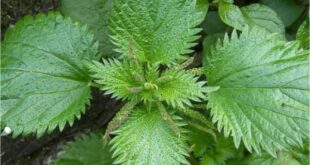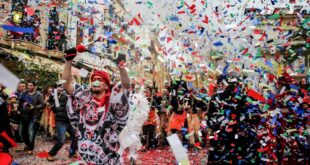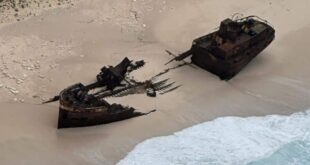Zakynthos Informer goes Turtle nest tracking.
After an invitation by Kostas Papafitsoros, an ARCHELON volunteer, researcher and sea turtle photographer, Zakynthos informer went turtle nest tracking.
The idea was to see what the ARCHELON volunteers do, as so many of our members have asked.
Originally, I was asked to meet them at a way too early time in the morning for me as usually I’m asleep.. 05.30a.m!!! Yes this is the time they start their tracking.
It turned out though that as I was not an “official” volunteer and due to protocols I would have to meet them at 07.00a.m. This is the actual time the beach is open to visitors.
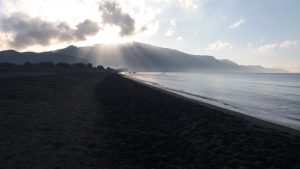
As I walked down onto the beach I searched for the team. They had already started in what they call the “A” section of Laganas Bay and were making their way up towards Kalamaki beach.
On approaching, I noticed their blue T-shirts and gave a signal to Kosta that I was on my way. After being introduced to Nikoletta, the Zakynthos Project Manager and a new volunteer Elena from Spain we started our quest in search for turtle nests.
![]()
It was exciting being with the volunteers, Nikoletta and Kosta had so much information to share. Me being inquisitive was asking anything that just popped into my head as we walked along the beach. Elena on her part was quick to follow the directions of the two experienced members. She seemed to fit right in even though it was her first day.
![]()
Tracking along the beach.
The first lot of tracks showed us a female trying to attempt but without success, for some reason she aborted her attempt. I really didn’t think sea turtles would abort attempts especially having made their way up the sand looking for the perfect spot. We moved on…..
![]()
We came across some more tracks; I was excited to see whether there was a nest or not. As we were following the tracks Kosta told me that this particular track tells us that the female has lost her back left flipper.
Obviously amazed at how he came to that conclusion I asked him how he could tell. “It’s the tracks, look here” he said. Showing me some sort of track that to me didn’t mean much but to a train eyed like Kosta, it certainly gave every little detail he needed. “She’s made a right mess here” as he moved further up the track showing me the attempted nest. “If we were here we would have helped her dig so she could have laid her eggs, unfortunately we weren’t and this is the result.” A pile of sand that looked like some kids had piled their sand buckets into one heap.
Thinking of the difficult task she made to attempt her nest and not succeeding saddened me. Why was this particular turtle without a back flipper, what could of caused that?
“Most of the time, in situations like these, it’s due to fishing lines, they become wrapped around their flippers cutting off circulation and of course the end result is their flippers are destroyed.” Kosta told me.
![]()
Moving forward.
![]()
![]()
How can one recognize a turtle nest and if she has laid her eggs or not?
Kosta went on to explain.
Since most nesting occurs at night, scientists rely on using trails and tracks to identify where a nest has been laid. We are like trackers. A track is an impression of a single flipper on the sandy beach. Long lines of tracks showing an animal’s movement and behaviour are called trails. To find the nest we use visual clues to determine whether the turtle actually made a nest or if it was a ‘false crawl’ (non-nesting emergence). Once we have found the nest we then go about recording it. We gently brush away some of the sand to locate the top of the egg chamber.
Scientists measure the width of a sea turtle’s track, called the straddle, as well as note the crawl pattern of each species to tell what kind of turtle laid a nest. In this case there is no need as we already know the species. We start out early in the morning before sunrise. When we spot a nest, we mark it with stakes and measure its location and depth. We record all the details and, if necessary, may cover it with a wooden cage.
![]()
As we moved down the coastline we actually identified 4 nests and a few that were “false crawl” meaning they attempted but gave up and returned to the sea. The volunteers also made sure that the coast line was “prepared” for nesting. In other words they filled in holes that had been made by visitors on the beach. Flattened sand castles that had been left erected. all for the protection of the sea turtles. Thus making a safe passage for them to lay their eggs and of course when hatchlings start to make their way back to the sea.
![]()
![]()
At the end I spoke to all three team members this is what they had to say..
VOICE RECODINGS… just hit the orange play button.
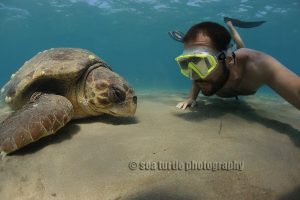
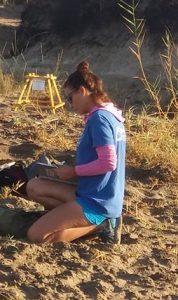
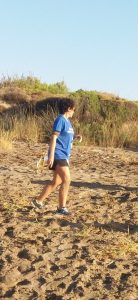
Record year or not due to covid restrictions?
So far in Zakynthos the amount of nests that have been recorded are high. The nesting period starts from May to October and up until now we have recorded over a thousands nests.
![]()
Of course a question I posed to Kosta was; “Are we having a record year due to covid restrictions?
He explained :- So one needs to be careful here: it is very easy and tempting to attribute the very good nesting year to the lockdown. It does make a good story indeed but we are not here to tell good stories, we are here to look at the data and facts and judge accordingly.
There are several reasons though why we cannot say if it is. There is no way to verify this given only one season. The number of turtles that left the foraging grounds to breed was somehow pre-decided independently of the situation in the breeding grounds. Besides, we have no indication that the presence of tourists reduces the number of nests.
Maybe, we might have less propeller accidents (but I doubt we will have anything significant here either). Another argument, based on the latest study the impact of boats has to nesting turtles in Zakynthos is very likely to be minimal.
Zakynthos Informer would like to thank ARCHELON for a wonderful experience. I certainly learnt a lot within the few hours I had spent with them.
ARCHELON, a team that worked amazingly well as a unit. Professionals with a great passion for what they do. ARCHELON, protecting a vulnerable species known as Caretta Caretta. Volunteers in every essence of the word!
What to do if you find an injured or dead sea turtle.
If you see a sick, injured or dead turtle we would ask that you report it immediately. You can contact ARCHELON, on +30 6940454956. the Port Police of Zakynthos on +30 2695 028117 or The National Marine Park of Zakynthos on + 30 26950 29870
Main feature photo:- Anna Lamaj, ARCHELON.
You may want to read:-
https://zakynthosinformer.com/zakynthos-loggerhead-turtles-caretta-caretta/
 Zakynthos Informer Zakynthos Informer
Zakynthos Informer Zakynthos Informer

